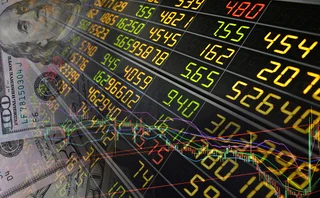No big boost to UK dark trading after Brexit
Expected explosion in hidden equity liquidity has failed to materialize

When the UK—after its exit from the European Union—started stripping away regulation that forced equity trading onto lit venues, critics said it would lead to an explosion of dark trading in London. So far, their concerns seem overblown.
Data collected by Risk.net, a sibling publication of WatersTechnology, from exchanges and analytics providers shows that dark trading volumes have stayed more-or-less flat. The controversial removal in the UK of volume caps that form part of EU rules has had “no material impact” on the UK’s share of dark trading, says Natan Tiefenbrun, president of dark pool operator Cboe Europe.
Cboe says hidden liquidity was already rising in the lead up to Brexit and has stayed fairly constant since. Total dark trading in the top 100 UK stocks measured in its index averaged 14.3% to April 2023 since the Brexit transition period ended in January 2021.
Multiple data sources tell the same story. Dealer-to-client venue Liquidnet says by its numbers that UK dark trading has risen from 12.8% on average in 2020 to 13.7% in Q1 2023. And analytics provider BMLL Technologies says UK dark market share in the top 100 UK stocks has been relatively stable since 2020 at around 8.6%, noting this number is lower than Liquidnet’s because Liquidnet’s calculation doesn’t include price-forming over-the-counter trading.
Limits on dark pool trading volumes that are part of the EU’s Mifid II reform of financial markets aim to force more EU share transactions onto so-called lit venues to improve price transparency and benefit end-investors.
Mifid II requires trading venues to make bid and offer prices public, as well as information on the depth of trading interests. In dark trading, market participants make use of rule exemptions to circumvent these pre-trade transparency requirements.
Critics claim dark trading drains liquidity from lit venues to the detriment of investors.
The EU rules, though, have proved unpopular with investment managers. And when the UK relaxed certain restrictions on dark trading in early 2021, European investors worried about UK rivals benefitting from a competitive advantage.
Not busting much
Since then, however, the percentage of trades has only “slowly crept up”, says Gareth Exton, Liquidnet’s head of execution and quantitative services Emea. The proportion of on-exchange volume trading in the dark in the EU27 has fallen from 9% in 2020 to 8.1% in 2023, across 11 trading hubs.
Dark trading in mid-cap stocks is more popular than for large caps, but the trend across both remains roughly the same, according to data from analytics firm big xyt.
Vincent Boquillon, head of equities at Euronext, which operates a lit exchange, says he has seen no “huge shift in liquidity nor a material distortion between the UK and the EU”.
Mike Horan, head of Emea trading at outsourced trading provider BNY Mellon Pershing, agrees there has been no “massive migration” to dark trading.
The head of market structure at a systematic internalizer—an investment firm that trades on its own account—says that since the UK lifted its restrictions, dark trading “didn't just suddenly go gangbusters”.
Regulators are likely to welcome the absence of change and appeared relaxed about the lack of any meaningful shift. A spokesperson for the European Securities and Markets Authority says in respect to dark trading: “To date we have not identified any concerning developments.”
The EU’s so-called double volume cap limits the proportion of dark trading of individual stocks in the EU to 4% for a single venue or 8% for all venues, with breaches leading to a suspension of dark trading in those stocks.
In December 2020, the UK announced it would not automatically apply the DVC to UK equities and in March 2021 extended this to all equities. Now the DVC looks likely to be ditched entirely.
In a survey by consultancy Coalition Greenwich, four in five traders in the UK said scrapping the DVC would make them more likely to trade in London.
European buy-siders, meanwhile, would like more dark trading options and have urged the EU to follow the UK’s path.
A spokesperson for German funds association BVI calls for greater use of dark venues in the EU. “They provide liquidity services that are critical for end-investors and that cannot be substituted by sole access to lit multilateral venues,” says a BVI spokesperson.
Erik Einerth, senior expert at the Swedish Securities Markets Association, says many of its members connect to dark liquidity in the UK “to provide best execution and find liquidity without moving the market”. He advocates for the EU to follow the UK to prevent “regulatory arbitrage”.
A review of the European markets regime by the European Commission shows some support for relaxing transparency requirements for trading in financial instruments, as the UK has done.
Only users who have a paid subscription or are part of a corporate subscription are able to print or copy content.
To access these options, along with all other subscription benefits, please contact info@waterstechnology.com or view our subscription options here: http://subscriptions.waterstechnology.com/subscribe
You are currently unable to print this content. Please contact info@waterstechnology.com to find out more.
You are currently unable to copy this content. Please contact info@waterstechnology.com to find out more.
Copyright Infopro Digital Limited. All rights reserved.
As outlined in our terms and conditions, https://www.infopro-digital.com/terms-and-conditions/subscriptions/ (point 2.4), printing is limited to a single copy.
If you would like to purchase additional rights please email info@waterstechnology.com
Copyright Infopro Digital Limited. All rights reserved.
You may share this content using our article tools. As outlined in our terms and conditions, https://www.infopro-digital.com/terms-and-conditions/subscriptions/ (clause 2.4), an Authorised User may only make one copy of the materials for their own personal use. You must also comply with the restrictions in clause 2.5.
If you would like to purchase additional rights please email info@waterstechnology.com
More on Market access
Hunting for reliable low latency, HFTs look to novel techs in 2023
WatersTechnology looks at advancements in market data latency technology and what role the cloud can play.
Managing the FX challenge for T+1
As firms prepare for T+1 in May 2024, DTCC’s Val Wotton says they should also consider the complexities for cross-border trades.
ASX, SGX earnings driven by diversified revenue
After the Chess disaster, ASX focuses on rebuilding confidence, while SGX continues investing in its derivatives business. Meanwhile, HKEx mulls data play.
Shall we compare thee to a multilateral trading venue?
As regulators confirm that perimeter guidance applies to tech firms, the focus shifts to enforcement.
IMD & IRD Awards 2023 winner's interview: MarketAxess
MarketAxess won the best AI/machine learning data initiative in this year’s Inside Market Data & Inside Reference Data Awards, thanks to its CP+ bond pricing engine.
Shaking things up in the dark: Vendors build new tools for dark-pool trading in Asia-Pacific
New conditional order venues could bring more liquidity and sophistication to dark pool trading in the region.
Competing CTPs won’t work, warn EU firms, calling for single tape provider
As the industry awaits upcoming EC proposals, some firms are voicing concerns that mandating multiple CTPs could create fresh problems around data fragmentation and connectivity costs.
This Week: Bloomberg/Goldman Sachs, Broadridge, Rimes, and more
A summary of some of the past week's financial technology news.







